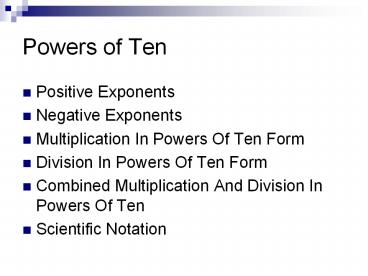Powers of Ten - PowerPoint PPT Presentation
Title:
Powers of Ten
Description:
Powers of Ten Positive Exponents Negative Exponents Multiplication In Powers Of Ten Form Division In Powers Of Ten Form Combined Multiplication And Division In Powers ... – PowerPoint PPT presentation
Number of Views:1506
Avg rating:3.0/5.0
Title: Powers of Ten
1
Powers of Ten
- Positive Exponents
- Negative Exponents
- Multiplication In Powers Of Ten Form
- Division In Powers Of Ten Form
- Combined Multiplication And Division In Powers Of
Ten - Scientific Notation
2
Powers of Ten (cont.)
- Problems With Complex Denominators Or Numerators
- Reciprocals
- Powers And Roots In Base Ten
3
Positive Exponents
- Large or small numbers can be handled easily by
using a system of notation called powers of ten. - The powers of ten refers to the exponents of ten.
This exponent is the number of times ten is
multiplied by itself. For example 10 x 10 x 10 x
10 104. The four is the exponent of ten. - Exponents determine the number of places the
decimal point is moved from the present decimal
point toward the new decimal point. - If no number is given with the power of ten,
insert 1. An example is 103 1. x 103 1000. - 4.56 x 103 4560. Notice the decimal point moved
to right with a positive exponent. - To convert from a powers of ten to a number,
simply write 1 and follow it by the number of 0's
in the exponent if the exponent is a positive
number.
4
Negative Exponents
- Numbers less than 0 are dealt with by using
negative exponents. - Negative exponents determine the number of places
the decimal point is moved from the present
decimal point towards the left to the new decimal
point. - An example of this is 10-3 0.001.
- Also 78.9 x 10-4 .00789
5
Multiplication In Powers Of Ten Form
- Multiplication of terms with powers of 10 is
simply a matter of adding the powers. - 105 x 103 108
6
Division In Powers Of Ten Form
- Division of numbers containing powers of ten
involves subtraction of the exponents. - 103/102 101
7
Combined Multiplication And Division In Powers Of
Ten
- This process is one of adding or subtracting the
powers of ten as required. - The powers of ten are added or subtracted using
the same rules as adding or subtracting signed
numbers. - To move a power of ten from a denominator to a
numerator, simply change the sign of the
exponent. 1/103 10-3. The opposite change is
also true.
8
Scientific Notation
- A very convenient method of expressing the
numbers we use in electronics is the use of
scientific notation. - Scientific notion is the placing of a decimal
point after the MSD and adding a power of ten. - The exponent of the power of ten will be the
number of places the decimal point is moved. - In the original number, count the number of
decimal places the decimal point moves left. This
is the positive value of the exponent. - Move the decimal point to the right and the
exponent is negative.
9
Problems With Complex Denominators Or Numerators
- If your problem has a complex denominator or
numerator, the fraction line says that everything
in the numerator is surrounded by imaginary
parentheses and must be done first. - Likewise everything in the denominator has a pair
of parentheses and must be combined before the
division takes place. This is also the clue on
how to do this with your calculator.
10
Reciprocals
- A reciprocal of a number is one divided by that
number. - A reciprocal of a fraction (like 2/3) is that
fraction flipped over (3/2). - Most calculators have a separate key to give you
the reciprocal of any number in its display.
11
Powers And Roots In Base Ten
- To raise a power of ten to a power simply
multiply the exponents. - To find the square root of a number, raise that
number to the 1/2 power.

